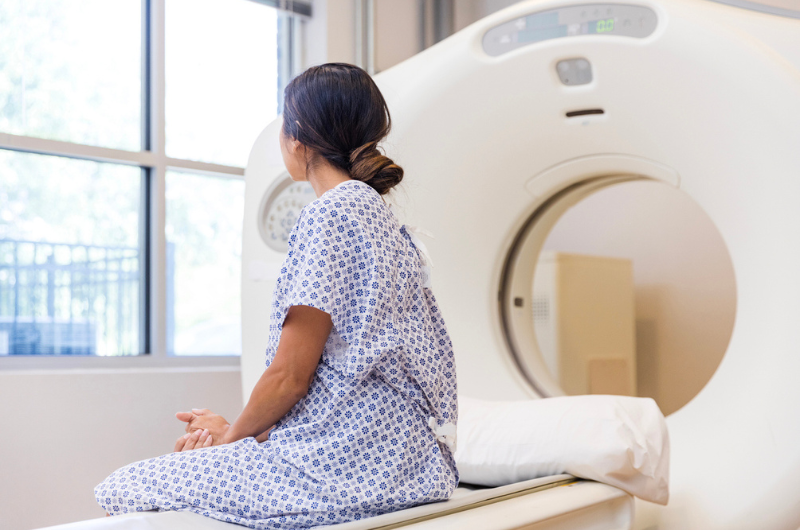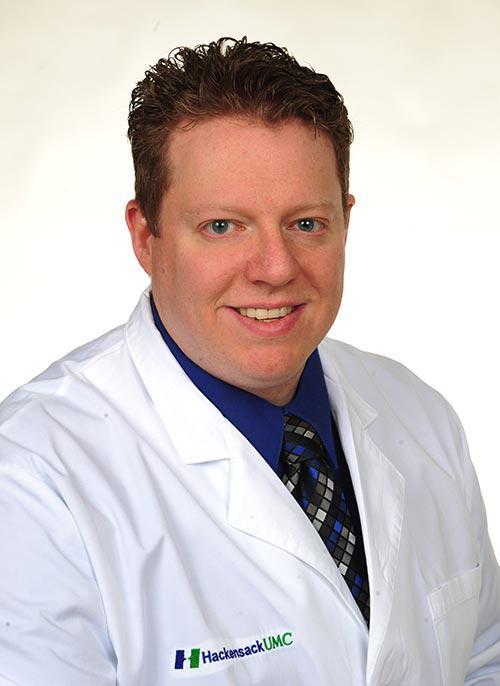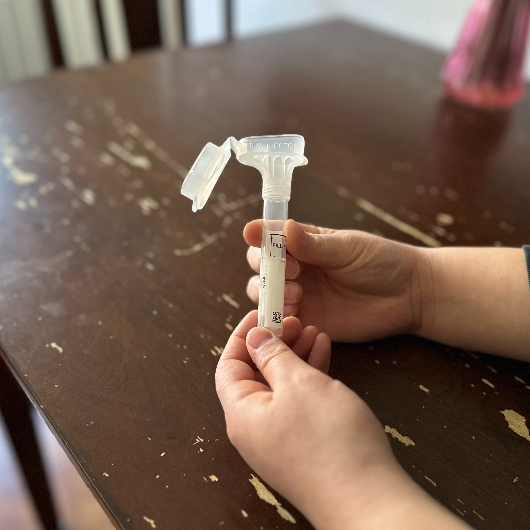Don't Wait for Symptoms: A Powerful Plea for Lung Cancer Screening from a Former Smoker

July 03, 2025
No cough, no shortness of breath, no coughing up blood, and yet, a positive diagnosis for lung cancer.
On November 28, 2024, Denise was preparing for her yearly Florida trip. She snuck in one last visit to her doctor to get her prescriptions filled before she left.
Detecting Cancer Early, Before Symptoms Arise
As a long-time nurse, Denise knows the importance of preventative screenings. “I was thinking to myself, I get my mammogram and my colonoscopy; I just want to rule out my lungs now.”
Although Denise had quit smoking over 20 years ago, having smoked for almost 35 years, she knew she should keep a close tab on her lungs.
Denise mentioned to her doctor that she had heard about low-dose CT (LDCT) scans and asked if she could have one done. Her doctor ordered the test, and Denise remembers, "They called me the next day to schedule it. I probably would have forgotten about it since I felt fine."
“The test is easy; it was out of the hospital and took me five minutes,” she says. “There was no prep; I just walked in, got the test and left.”
The Call No One Wants
Four days later, Denise was visiting a friend who was receiving chemotherapy treatment. “I was at the chemo place with my friend when my doctor called me and said you have a positive result,” she says. “It was so odd, standing there in the hall, thinking, am I now going to be the one in the chair?”
A nodule (a small lump) was found on Denise’s lung. An additional PET scan showed that it was suspicious for cancer, but it likely hadn’t spread to other parts of her body.
Shaken by the news, Denise called her twin sister for support. “She said, ‘You may have dodged a bullet because you don’t have symptoms,’” Denise says. “The best support was knowing that I was probably going to have a good outcome because I caught this before it caught me,” Denise says.
Robotic Surgery and Getting Back To Normal
Thinking of what to do next and where to get care, Denise met with thoracic surgical oncologist, Geoffrey B. Pelz, M.D., from Hackensack University Medical Center.
“Dr. Pelz looked at my PET scan, and said there was no point in doing a biopsy since it looked like it was contained, and they did surgery two and a half weeks later,” she notes.
Because the cancer was found early, Denise was able to have minimally invasive robotic surgery. “We took out just the upper part of the lower lobe, which helps save a fair amount of lung function,” Dr. Pelz notes. “She stayed overnight in the hospital. The morning after, we checked her over, she had a final x-ray and was able to go home the day after surgery.”
“The robotic surgery was so easy, I had very little pain, no trouble breathing,” she says. “It felt like someone punched me lightly in the side.”
“Once you have symptoms, it’s too far gone; early detection is the only way. If I hadn’t said anything or gotten the test, I probably would have had metastatic cancer two years from now,” she says. “Somebody must have been looking out for me, a guardian angel.”
What Are Symptoms of Lung Cancer?
Most people with lung cancer don’t typically experience symptoms until the cancer has spread.
The most common symptoms of lung cancer are:
- A cough that won’t quit or worsens over time
- Coughing up blood
- Chest pain that worsens with deep breathing, coughing or laughing
- A raspy voice
- Loss of appetite
- Unintended weight loss
- Shortness of breath
- Feeling tired or weak
- Repeated lung infections like bronchitis or pneumonia
- Wheezing while breathing
If lung cancer spreads to other parts of the body, it can cause other symptoms, including:
- Bone aches, especially in the back or hips
- Headaches, weakness, numbness, dizziness, problems with balance or seizures, if cancer has spread to the brain
- Yellow skin or eyes, if cancer spreads to the liver
- Swollen lymph nodes
How Can You Prevent Lung Cancer?
The best way to reduce your risk of lung cancer is not to smoke.
While there is no way to completely eliminate your risk of the disease, there are specific steps you can take to reduce your risk, including:
- Don’t smoke and steer clear of secondhand smoke – smoking is the number one cause of lung cancer.
- Test your home for radon. Radon is a natural radioactive gas that develops from the decay of uranium (a common element found in soil and rock). This decay can seep into homes through cracks in the foundation, walls and other holes. Radon exposure is the second most common cause of lung cancer deaths.
- Limit exposure and use proper protective equipment if you are exposed to asbestos. Those who work in construction, shipbuilding and insulation installation face the highest risk of asbestos exposure. A fibrous, heat-resistant material, breathing in asbestos fibers can lead to lung cancer and other dangerous diseases like mesothelioma, a cancer that lines the lungs.
- Exercise and maintain a nutritious diet.
Who Should Get Lung Cancer Prevention Screenings?
Lung cancer is the second most common cancer in the U.S. and the leading cause of cancer death.
“Lung cancer is most treatable in the earlier stages, but unfortunately, many times it goes undetected, and is only found once symptoms emerge and the cancer is much further along,” says Dr. Pelz. “Only about 27% of cases are diagnosed at an early stage when treatment is much more effective.”
An LDCT scan can help detect lung cancer early. You should consider this scan if:
- You’re between 50 and 80 years old.
- You smoke now or used to smoke.
- You have a 20-pack-year history.
“ ‘Pack years’ is a way to measure how much someone has smoked over time,” Dr. Pelz explains. “You multiply the number of packs per day by the number of years. So, for example, if you’ve smoked a pack of cigarettes a day for 20 years, or two packs a day for 10 years, that’s a 20-pack-year history.”
If you have risk factors or are concerned about your risk, talk to your doctor about LDCT scanning.
“It’s important to spread awareness of how important these scans are; it’s the best way to catch things early on,” he says.
What is a Low-Dose CT Scan Like?
An LDCT is a simple way to check for lung cancer.
- It's a quick scan where you lie on a table and hold your breath for a few seconds.
- You don't need needles, medicines or special dyes for the scan.
- The machine is an open donut shape – “Some patients can get claustrophobic or think this is going to be tunnel-like, like an MRI, but it’s much quicker, easier, and you’re not enclosed; it’s much more open,” explains Dr. Pelz.
- It takes a few minutes, and then you’re all done.
“As with all tests, nothing is perfect, but like anything in medicine, you have to weigh the risks with the benefits,” says Dr. Pelz. “The scans could pick up an abnormal reading, leading to extra testing or surgery, when it might not be lung cancer. But the risk of dying from untreated lung cancer is far more harmful than additional tests or scans, in terms of potential harm.”
Are Low-Dose CT Scans Covered by Insurance?
Most health insurance, including Medicare, will help pay for lung cancer scans if your doctor recommends one. If the scan finds something unusual, you might need more tests. These extra tests could have added costs, like a co-pay or deductible. It's always a good idea to check with your insurance company to see exactly what they'll pay for.
Living Cancer Free
A few weeks after her surgery, Denise was able to take her planned trip to Florida and get back to spending time with her family and beloved grandchildren. “I look forward to continuing to work as a nurse, seeing my grandchildren grow up, and continuing to live healthy and pain-free,” she says.

Denise still keeps her friend company at her chemotherapy treatments and reflects on her journey, “Now I’m back sitting with her, and I’m cancer-free because of early screening.”
Next Steps & Resources:
- Meet our expert: Geoffrey B. Pelz, M.D.
- To make an appointment with a doctor near you, call 800-822-8905 or visit our website.
- Learn more about lung cancer care at Hackensack Meridian Health.
- Learn more about our Thoracic Surgery Program.
The material provided through HealthU is intended to be used as general information only and should not replace the advice of your physician. Always consult your physician for individual care.






